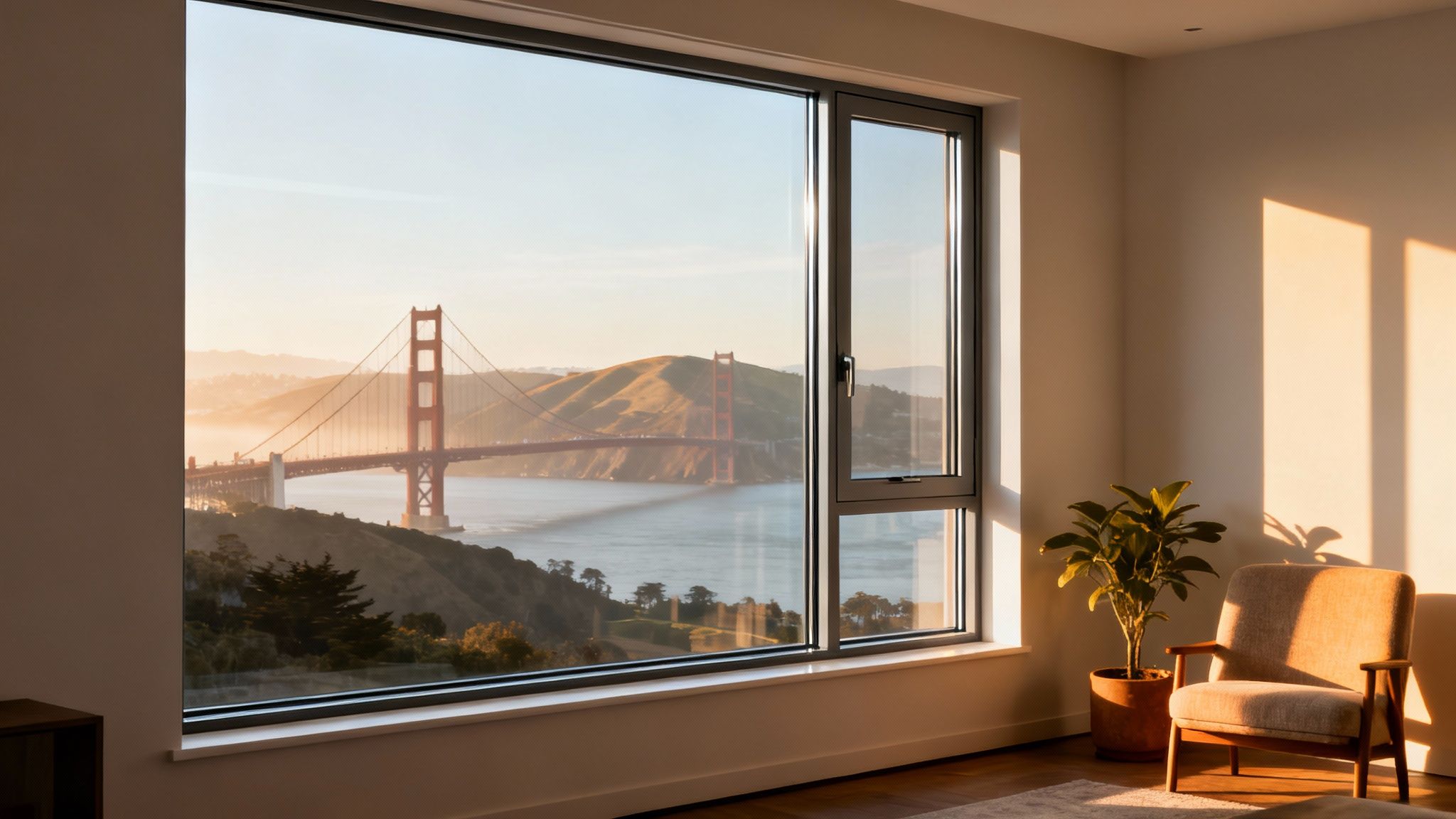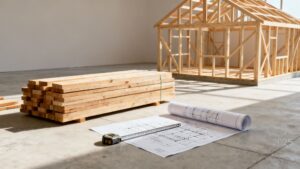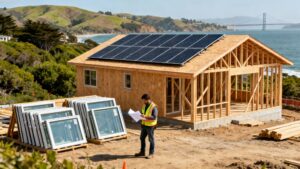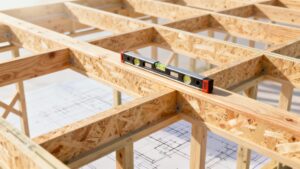Choosing to replace your windows is a big decision for any Bay Area homeowner. It's about more than a new look. It's a key investment in your home's comfort and energy efficiency.
This guide will explain California's Title 24 energy code. We'll show you how to pick windows that meet these standards and improve your home. This information is helpful for homeowners, contractors, and builders in Berkeley, Oakland, and beyond.
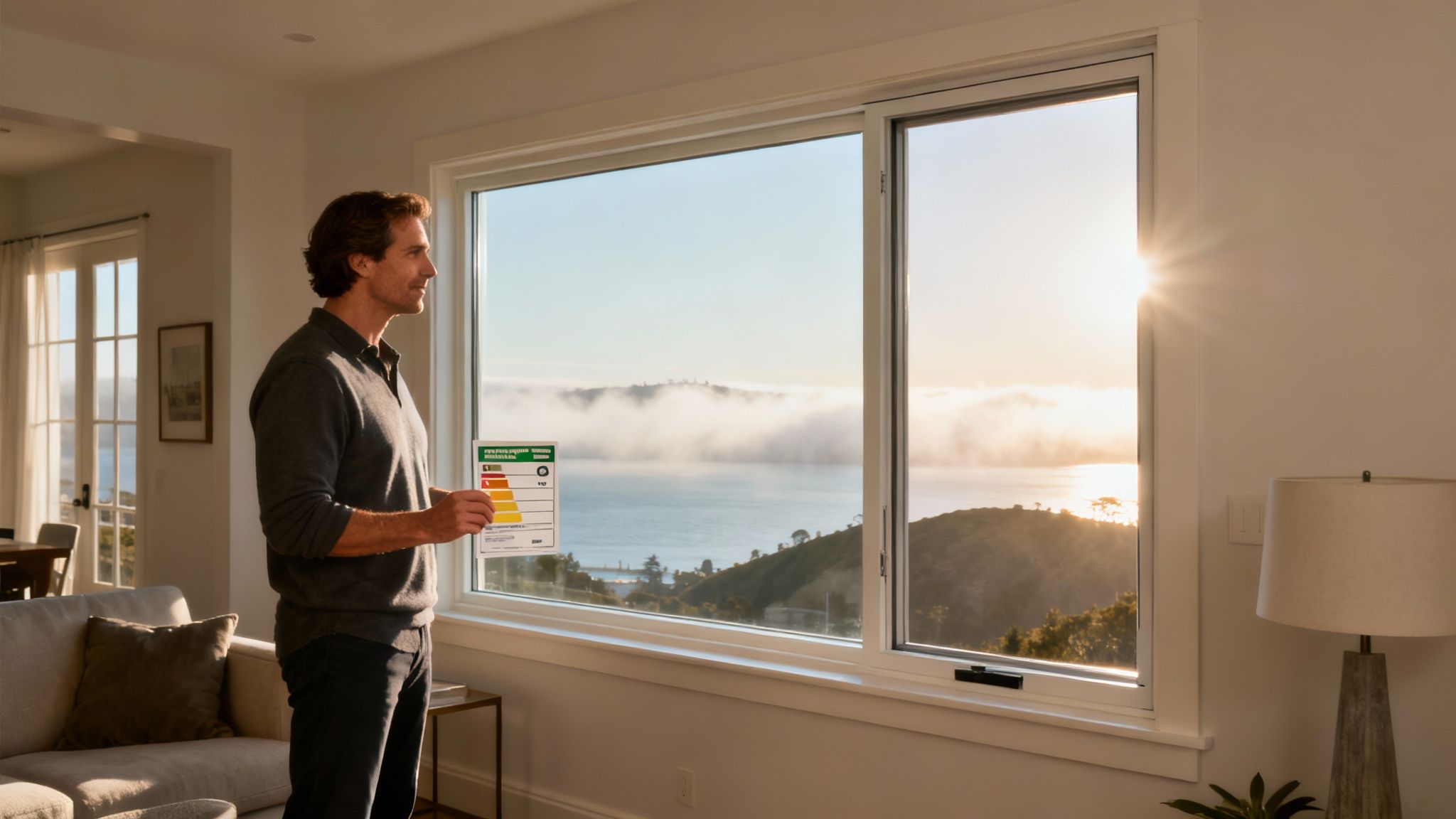
Why Title 24 Matters for Your Bay Area Home
If you live in Berkeley or Oakland, you’ve likely heard of Title 24. It’s California's rulebook for making buildings more energy-efficient. Your windows are a major part of this plan.
These rules are not suggestions; they are legal requirements. They help reduce energy use, lower utility bills, and make our homes more comfortable.
The Impact on Your Window Choices
With high interest rates, many homeowners are remodeling instead of moving. Upgrading to high-performance windows is one of the best improvements you can make. It helps with our local microclimates, from foggy San Francisco mornings to hot East Bay afternoons.
California’s Title 24 standards are some of the strictest in the nation. They require specific features like advanced insulation and special Low-E coatings to reduce heat transfer. Because of these rules, homeowners in California typically pay between $450 and $1,200 per window.
The higher cost is due to the required energy-efficient technology. You can explore more about these regional cost factors to understand the investment better.
What This Means for Homeowners
Understanding Title 24 helps you make a smart choice that pays off for years. This guide breaks down everything you need to know. We’ll cover energy labels and choosing the right window for your Bay Area climate.
At Truitt & White, we offer expert guidance on Title 24-compliant windows. We provide premium brands and custom options from our "Berkeley building materials" hub to ensure your project succeeds.
Decoding Window Energy Labels for Title 24
Let's simplify Title 24. Think of it as California's rulebook for energy efficiency in buildings. Your windows play a big part in meeting these rules.
The technical terms on a window's energy label can be confusing. It’s helpful to compare them to nutrition facts on food. You check a window's energy numbers to see if it’s a healthy choice for your home.
The Two Most Important Ratings
The two most important numbers are the U-factor and the Solar Heat Gain Coefficient (SHGC). These ratings are key to Title 24 compliance and your daily comfort. Getting them right is essential for any window replacement in Berkeley or Oakland.
Let’s break down what each one means:
-
U-Factor (The Insulator): This number shows how well a window prevents heat from escaping. A lower U-factor means better insulation, which keeps your home warm in the winter. Think of it like a good winter coat for your house. For more details, read our guide to understanding R-value in insulation.
-
Solar Heat Gain Coefficient (The Sun Blocker): SHGC measures how well a window blocks heat from the sun. A lower SHGC means less solar heat gets through, keeping your home cool on hot days. This is crucial for inland areas of the East Bay.
For most Bay Area homes, the goal is a balance. You want a low U-factor to keep heat in during winter and a low SHGC to keep unwanted heat out during summer.
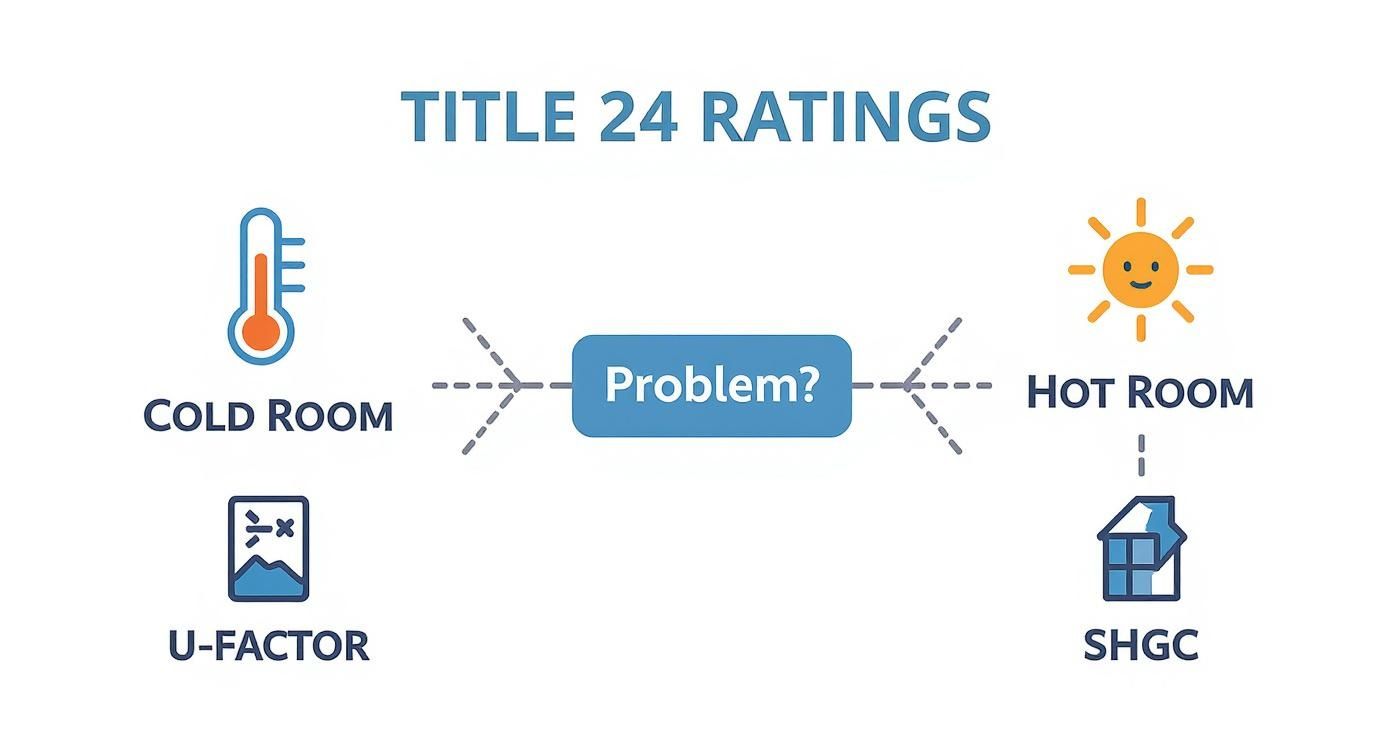
Other Key Performance Metrics
Title 24 also considers two other important ratings. These affect your home's light and air quality.
Visible Transmittance (VT) measures how much visible light passes through the glass. A higher VT number means more natural daylight. Modern windows let in plenty of light while blocking heat and UV rays.
Air Leakage measures how much air can sneak through cracks in the window. A lower rating means a tighter seal, which stops drafts. According to ENERGY STAR, drafts can waste 5% to 30% of your home's energy.
Understanding these four ratings—U-factor, SHGC, VT, and Air Leakage—helps you choose windows that meet California law and create a comfortable living space.
Choosing Windows for Your Bay Area Climate Zone
The Bay Area has many microclimates. A foggy morning in San Francisco is very different from a hot afternoon in Walnut Creek. Your windows need to be suited to your specific location.
California has 16 climate zones. Most of the coastal Bay Area, including Berkeley and Oakland, is in Climate Zone 3. This zone has mild weather. Inland areas like Concord are in Climate Zone 12, which has hotter summers.
Finding the Right Window for Your Zone
For homes in the cooler coastal Zone 3, preventing heat loss is important. A window with a very low U-factor is best. It will keep your home warm without running the furnace constantly.
In the hotter inland Zone 12, blocking solar heat is the priority. You’ll want a window with a low SHGC to keep your home cool. A low U-factor is still important for chilly winter nights.
Here’s a quick guide:
- For Coastal Homes (Zone 3): Prioritize a low U-factor, ideally 0.30 or lower. This provides the best insulation.
- For Inland Homes (Zone 12): Focus on the lowest SHGC you can find, ideally 0.25 or lower. This will block intense sun.
How Climate Affects Cost
Choosing the wrong window for your climate is a costly mistake. It can make your home uncomfortable and increase your energy bills. Working with a knowledgeable supplier like Truitt & White, a trusted "lumberyard near Oakland," ensures you get it right.
We can help you find windows with the perfect U-factor and SHGC for your home. Some brands are specifically designed for the Bay Area's varied weather. You can learn more about All-Weather windows built to withstand the Bay Area in our detailed guide.
How New Windows Transform Home Comfort
Beyond meeting codes, the real reason to upgrade windows is comfort. Old windows often cause drafts, hot spots, and chilly rooms. Many older Bay Area homes have single-pane windows that don't insulate well.
Modern, Title 24-compliant windows solve these problems. They turn your home into a more stable and comfortable place to live.

Benefits of High-Performance Windows
New windows plug the energy leaks in your home. Here’s how they improve your environment:
- Consistent Temperatures: Double-pane glass, argon gas fills, and Low-E coatings reduce heat transfer. This keeps rooms warmer in winter and cooler in summer.
- A Quieter Home: These features also block outside noise. This is great for homes in busy areas like Oakland or Berkeley.
- UV Protection: Low-E coatings block up to 99% of the sun's damaging UV rays. This protects your floors, furniture, and art from fading.
Weatherproofing and Sealing
Modern windows have advanced sealing systems. These create an airtight seal to stop drafts and air leakage. According to the U.S. Department of Energy, drafts can waste 5% to 30% of your home's energy.
Proper sealing is a key part of our guide on weatherproofing windows and doors. It ensures your windows perform their best. Exploring other window insulation solutions can also add another layer of thermal performance.
The Financial Benefits of Window Replacement
Is upgrading your windows a smart financial move? For Bay Area homeowners, the answer is yes. Think of window replacement as an investment that pays you back.
The first return you'll see is on your utility bills. According to ENERGY STAR, replacing old windows with certified ones can cut energy bills by an average of 12% nationwide. This means real savings every year.
Boosting Your Home's Resale Value
High-quality, Title 24-compliant windows also increase your home's resale value. In the competitive Bay Area market, energy-efficient homes are attractive to buyers. New windows are a major selling point.
Window replacement is one of the best home improvements for return on investment (ROI). Data from the National Association of Realtors shows a national average ROI of about 68% for vinyl window replacements. This means you can expect to get a large portion of your investment back when you sell.
Bay Area Window Cost Comparison
Here’s a look at estimated costs for different window frame materials in the Bay Area. These are estimates; your final cost will depend on size, style, and features.
| Frame Material | Average Cost Range (Installed) | Key Benefits |
|---|---|---|
| Vinyl | $450 – $900 | Affordable, low maintenance, good energy performance. |
| Fiberglass | $700 – $1,500 | Very durable, resists swelling, can be painted. |
| Wood | $1,000 – $2,000+ | Classic look, excellent insulator, high-end appeal. |
| Aluminum | $600 – $1,200 | Strong, slim frames for a modern look, durable. |
| Wood-Clad | $1,200 – $2,500+ | Wood interior for beauty, durable exterior for low maintenance. |
Available Rebates and Incentives
Local and federal incentives can help lower the initial cost. Check with your local utility provider or the Database of State Incentives for Renewables & Efficiency (DSIRE) to see what rebates are available. These programs make the investment more affordable.
To get a clearer idea of project costs, use our window replacement cost estimator for planning. Combining new windows with other strategies to reduce energy consumption in your home can lead to even greater savings.
Your Window Replacement Project Plan
Starting a window replacement project can feel overwhelming. Breaking it down into steps makes it much more manageable. This plan will guide you through the process.
First, assess your current windows. Do you feel drafts? Are some rooms too hot or cold? Note any damage or issues. This helps you set clear goals for the upgrade.
Define Your Goals and Choose Materials
Next, define your objectives. Are you trying to lower energy bills, reduce noise, or improve your home's look? Your goals will help you choose the right windows.
Then, it's time to pick your new windows. An expert team can help you decide on:
- Frame Material: Choose from vinyl, fiberglass, wood, aluminum, or wood-clad options based on your budget and style.
- Glazing Options: Select double or triple panes, Low-E coatings, and gas fills to meet your climate zone's needs.
- Operating Style: Pick window styles like casement or double-hung that fit your home's design.
Why Professional Installation is a Must
Even the best window will fail if installed incorrectly. Professional installation is crucial for a weathertight seal and proper operation. A bad installation can cause air leaks, water damage, and void your warranty.
While some homeowners consider DIY, proper flashing and sealing are complex. You can learn more in our article on replacing windows yourself. Working with experienced installers protects your investment and ensures your windows perform well for years.
The best way to start is by seeing your options in person. Visit our Window & Door Design Center in Berkeley for expert advice on "Bay Area windows and doors."
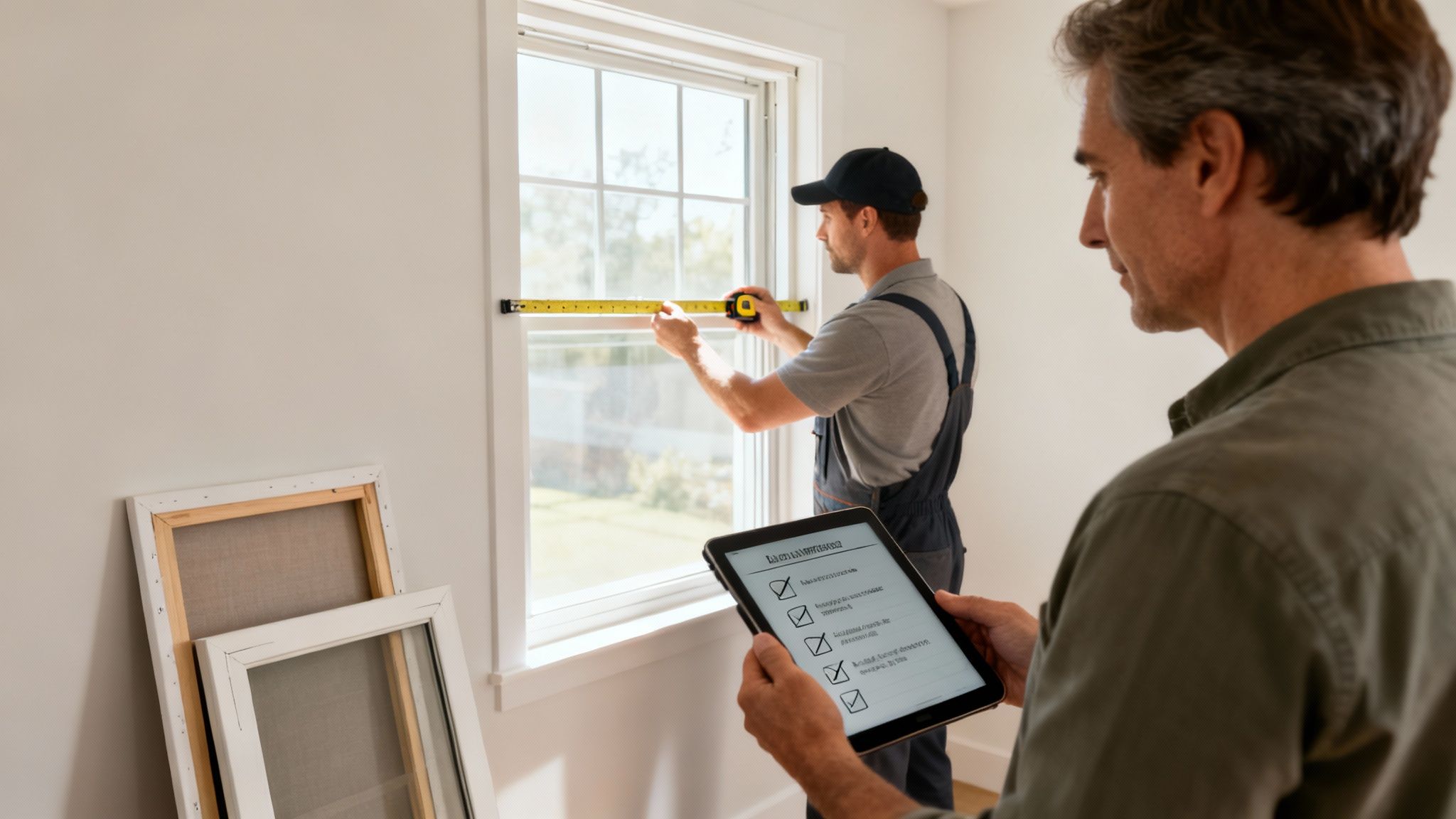
We invite you to explore Title 24-compliant solutions with our specialists. This direct connection simplifies the entire process.
Frequently Asked Questions About Bay Area Window Replacement
Window replacement projects often bring up many questions. Here are clear answers to what we hear most from homeowners and contractors in the Bay Area. This section will help you move forward with confidence.
1. Do I need a permit to replace my windows in the Bay Area?
Yes, in most cases you do. Cities like Berkeley, Oakland, and San Francisco require a building permit for window replacement. This ensures the installation is safe, meets local codes, and complies with California's Title 24 energy standards.
2. What is a Low-E coating and why is it important?
Low-E stands for "low-emissivity." It's a microscopic, invisible metallic coating on the glass that reflects heat. In winter, it keeps heat inside your home, and in summer, it reflects the sun's heat away. This technology is essential for energy efficiency and comfort.
3. How long does a typical window replacement project take?
For an average-sized home in the Bay Area, a professional crew can typically replace all the windows in two to five days. The exact timeline depends on the number of windows, their condition, and the complexity of the installation. Your contractor will provide a clear schedule before starting.
4. Can I replace just one window at a time?
Absolutely. Many homeowners replace windows in phases to fit their budget. You can start with the rooms that need it most, like those that are drafty or get too much sun. While this is a good approach, replacing all windows at once provides the biggest immediate improvement in comfort and energy savings.
5. Are triple-pane windows worth the extra cost in the Bay Area?
For most Bay Area homes, high-quality double-pane windows are sufficient. Modern double-pane windows with Low-E coatings and argon gas fills meet Title 24 standards and provide excellent comfort. Triple-pane windows offer superior insulation but are often unnecessary in our mild climate, making the extra cost hard to justify.
Ready to take the next step? The experts at Truitt & White are here to help you select the perfect Title 24-compliant windows for your home. Visit our Berkeley showroom for expert advice and to see our wide selection of premium products. Connect with us today to schedule a consultation.


